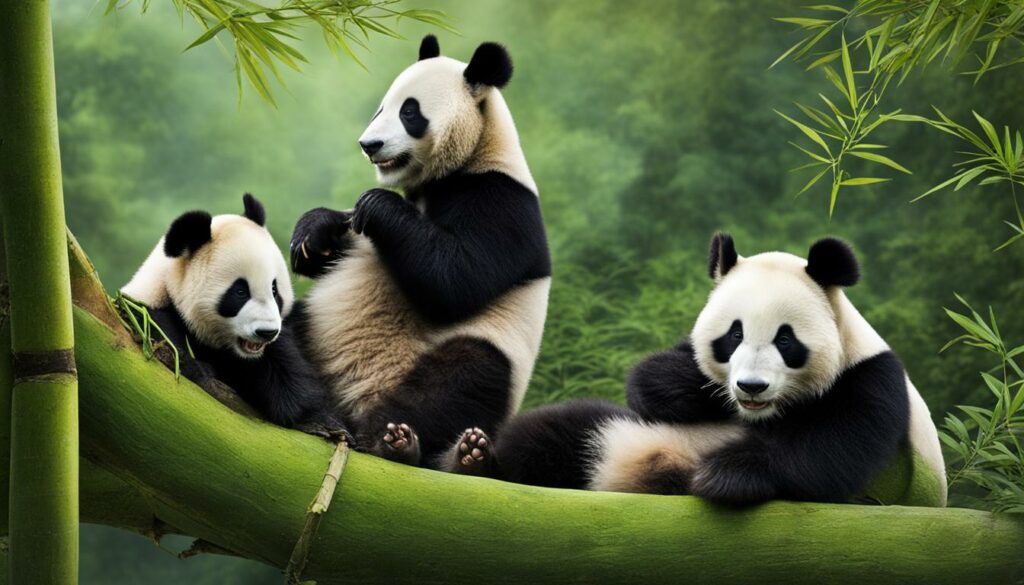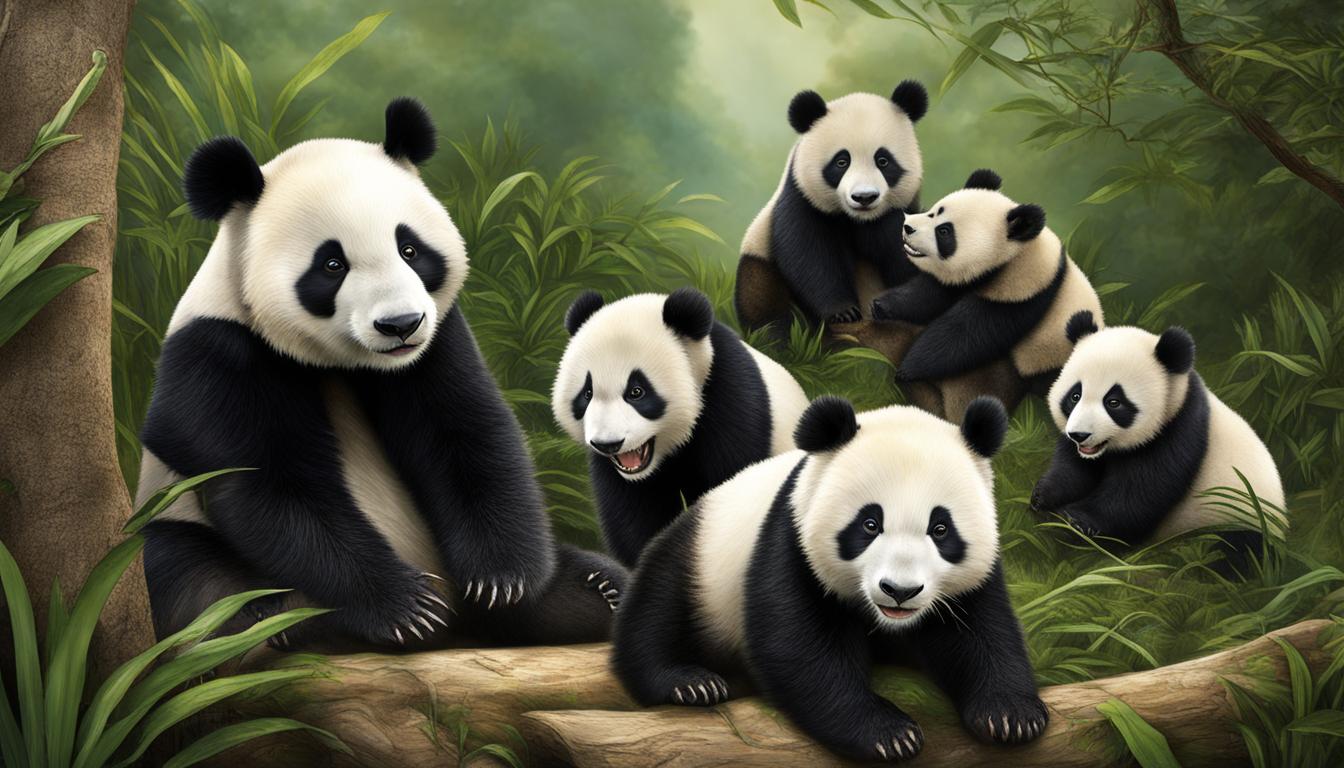When it comes to panda family dynamics, there’s a fascinating social structure and hierarchy at play. Giant pandas live in family groups consisting of a mother, her cubs, and occasionally a male. But what roles do these different family members play?
Let’s dive into the panda social structure and explore the panda group hierarchy. But first, take a moment to appreciate these adorable creatures:
Now, back to the panda family dynamics. The mother panda plays a crucial role in raising and caring for the cubs. She’s responsible for providing nourishment and protection, ensuring the well-being of her little ones. The male’s role is often limited to mating with the female, although there have been instances of males displaying some level of paternal care.
Within the family group, there is a hierarchy. The mother holds the dominant position, while the cubs occupy subordinate roles. This social structure is essential for the survival and overall well-being of the panda group as a whole.
Now that you have a glimpse into the panda’s family dynamics, let’s delve deeper into their breeding behavior and parental care in the next section.
Panda Breeding Behavior and Parental Care
Giant pandas have unique breeding behavior and exhibit dedicated parental care towards their cubs. Breeding typically takes place during a specific mating season, and males compete for the opportunity to mate with females. Once the female has successfully mated, she will usually give birth to one or two cubs.
The mother plays a vital role in the upbringing of the cubs. She provides constant care, nursing them and ensuring their well-being. The cubs heavily rely on their mother for nourishment and protection during their early stages of development. As they grow older, the mother gradually imparts important skills to the cubs, such as foraging for bamboo and climbing trees.
To visualize the development of panda cubs, refer to the table below:
| Stage of Development | Description |
|---|---|
| Newborn | Cubs are blind, hairless, and completely dependent on their mother. |
| One Month Old | The cubs’ eyes begin to open, and they start gaining weight rapidly. |
| Three Months Old | Cubs start to crawl and explore their surroundings. They may also start consuming small amounts of bamboo. |
| Six Months Old | The cubs’ teeth start to grow, and they begin eating bamboo. They are more independent but still rely on their mother for protection. |
As you can see, the mother’s care and guidance are crucial for the development of panda cubs. This strong maternal bond ensures their survival and prepares them for adulthood, where they will eventually play their own roles within the panda family group.
“The mother’s dedication to her cubs is extraordinary. She provides them with everything they need to thrive, teaching them essential skills for survival in the wild.”
Panda Social Interactions and Family Bonding
Giant pandas engage in a variety of social interactions that strengthen the bonds within their family groups. These interactions include cuddling, playing, and grooming each other. Through these behaviors, pandas express affection and build trust among family members. Grooming, in particular, not only helps keep their fur clean but also reinforces social bonds by promoting physical contact and communication.
Panda cubs benefit greatly from social interactions within the family. Playing with their siblings and engaging in gentle wrestling matches helps them develop important social and physical skills. These play sessions also facilitate the establishment of a hierarchical structure within the family group, which is essential for maintaining order and minimizing conflicts.
Sharing a territory is another crucial aspect of panda family dynamics. Each family group has a specific range within which they forage for bamboo and carry out their daily activities. This shared territory allows family members to stay close to each other, ensuring regular social interactions and strengthening family bonds. Additionally, by sharing a territory, the family group can work together to defend their space from potential intruders.
Socializing and bonding with other pandas is crucial for the well-being of these gentle creatures.
In summary, panda social interactions and family bonding play a vital role in the overall well-being and survival of the species. Through cuddling, playing, and grooming, pandas strengthen their social bonds and express affection. The cubs, in particular, benefit from these interactions as they learn important skills and establish their place within the family hierarchy. Sharing a territory allows for regular socializing and collaboration among family members, further enhancing their bond. By understanding and protecting these aspects of panda family dynamics, we can contribute to the conservation and preservation of these beloved creatures.

Panda Communication and Scent-marking Behavior
Giant pandas rely on various forms of communication to convey information within their family group. This includes vocalizations, body language, and scent-marking. Scent-marking, in particular, plays a crucial role in panda territory sharing and social interactions.
“Scent-marking is the panda’s way of communicating and establishing ownership over their territory,” explains Dr. Mei Ling, a leading panda researcher. “Pandas have scent glands on their cheeks and anogenital areas, which they use to mark trees, rocks, and other objects. This helps them communicate with other pandas in the area and avoid conflicts.”
Through scent-marking, pandas can signal their reproductive status, attract potential mates, and establish boundaries within their shared territory. The distinctive scent left behind acts as a form of communication, informing other pandas of their presence and intentions.
Research has shown that scent-marking is more prevalent during the mating season when pandas are actively seeking mates. It serves as a way for males to advertise their availability and females to indicate receptiveness. Along with vocalizations and body postures, scent-marking plays a significant role in mate attraction and courtship rituals.
Panda Family Dynamics in the Wild and Conservation Efforts
Giant pandas are known for their unique family dynamics, which play a crucial role in their survival and conservation in the wild. These dynamics involve the roles and interactions of different family members, contributing to the overall health and success of the panda population. Conserving these dynamics is essential for maintaining the genetic diversity and long-term viability of the species.
In the wild, panda family groups typically consist of a mother, her cubs, and occasionally a male. The mother plays a vital role in raising and caring for the cubs, providing them with nourishment and protection. Cubs rely heavily on their mother during their early stages of development, learning important skills from her that are necessary for their survival, such as foraging for bamboo and climbing trees. The male’s role in the family group is often limited to mating with the female, although there have been instances of males displaying some level of paternal care.
To ensure the continuation of panda family dynamics in the wild, various conservation efforts have been implemented. These efforts focus on protecting and conserving the natural habitat of pandas, as well as implementing breeding and reintroduction programs to increase their population. By safeguarding their habitat and promoting breeding and reintroduction, conservationists aim to maintain the family structure of pandas and prevent further decline in their numbers.
Conservation Efforts for Wild Panda Population
Conservation organizations have been working diligently to protect the wild panda population and their family dynamics. Efforts include creating and managing protected areas, establishing corridors to connect fragmented habitats, and conducting research on panda behavior and ecology. These initiatives help ensure that pandas have sufficient space and resources to thrive, allowing their family dynamics to continue.
One notable success story in panda conservation is the establishment of nature reserves in China, including the Wolong Nature Reserve and the Chengdu Research Base of Giant Panda Breeding. These reserves provide protected areas for pandas to live and breed, contributing to the growth of the wild panda population. Additionally, breeding and reintroduction programs have been implemented to increase the number of pandas in the wild, strengthening their family dynamics.
In summary, the family dynamics of giant pandas are crucial for their survival and conservation. The roles of different family members and their interactions contribute to the overall well-being and success of the panda population. Through ongoing conservation efforts and research, we can continue to learn more about panda family dynamics and work towards protecting and preserving these incredible creatures for future generations.
Table: Panda Conservation Efforts
| Conservation Efforts | Description |
|---|---|
| Protected Areas | Creation and management of nature reserves to provide a safe habitat for pandas. |
| Habitat Connectivity | Establishment of corridors to connect fragmented panda habitats, allowing for movement and gene flow. |
| Breeding and Reintroduction Programs | Implementation of programs to increase the wild panda population through captive breeding and reintroduction into their natural habitat. |
| Research and Monitoring | Conducting studies on panda behavior, ecology, and population dynamics to inform conservation strategies. |
By combining these conservation efforts, we can ensure the long-term survival of giant pandas and preserve their unique family dynamics in the wild.
Conclusion
The family dynamics of giant pandas are crucial for their survival and conservation. Understanding the roles that different family members play, such as the mother’s care for her cubs and the male’s involvement in mating, is essential in maintaining the well-being and success of the panda group.
Conserving these dynamics is vital for the long-term survival of the species. Efforts to protect their natural habitat and implement breeding and reintroduction programs are key in ensuring the continuation of panda family dynamics in the wild. By supporting these conservation efforts and conducting research, we can gain further insight into panda family dynamics and work towards protecting these amazing creatures for future generations.
Giant pandas have a unique social structure that contributes to the genetic diversity and overall health of the population. By preserving their family dynamics, we can help maintain the balance of the ecosystem and the well-being of these beloved animals. It is our responsibility to take action and protect the panda social structure for the benefit of both the pandas and the world we share.
Are the Family Dynamics of Giant Pandas and Koalas Similar?
The family dynamics of giant pandas and koalas are quite different, despite both species being known for their solitary nature. While giant pandas tend to be solitary animals, koalas have been observed to form loose social groups, but with no clear family roles in koala groups. This indicates a contrast in their social behaviors.
FAQ
What roles do different family members play in a giant panda group?
Giant pandas live in family groups consisting of a mother, her cubs, and occasionally a male. The mother plays a crucial role in raising and caring for the cubs, providing them with nourishment and protection. The male’s role in the family is often limited to mating with the female, although there have been instances of males displaying some level of paternal care. Within the family group, there is a hierarchy, with the mother being the dominant member and the cubs occupying subordinate positions. This social structure ensures the survival and well-being of the group as a whole.
What is panda breeding behavior and parental care like?
Breeding takes place during a specific mating season, and males compete for the opportunity to mate with females. Once the female has successfully mated, she will typically give birth to one or two cubs. The mother provides constant care to her cubs, nursing them and grooming them to ensure their health and well-being. Cubs rely heavily on their mother for nourishment and protection during their early stages of development. As the cubs grow older, the mother gradually teaches them important skills, such as foraging for bamboo and climbing trees.
How do pandas engage in social interactions and bond as a family?
Giant pandas engage in various social interactions to establish and maintain social bonds within the family group. These interactions include cuddling, playing, and grooming each other. These behaviors help strengthen the family bond and promote social cohesion. In addition, pandas have a defined territory that they share with other family members. Each family group has a specific range within which they forage for bamboo and engage in their daily activities. Sharing a territory allows the family members to stay close to each other and maintain social connections.
How do pandas communicate with each other and mark their territory?
Pandas use various forms of communication to convey information within their family group. This includes vocalizations, body language, and scent-marking. Scent-marking is particularly important for marking territory boundaries and signaling reproductive status. Pandas have scent glands on their cheeks and anogenital areas, which they rub against objects to leave their scent. This behavior helps establish ownership over a territory and communicate with other pandas in the area. It also helps attract potential mates and avoid conflicts with neighboring groups.
What is the importance of panda family dynamics in the wild and how are they conserved?
In the wild, giant panda family dynamics play a crucial role in the survival and conservation of the species. The size and structure of family groups contribute to the genetic diversity and long-term viability of the population. Efforts have been made to protect and conserve the natural habitat of pandas, as well as implement breeding and reintroduction programs to increase their population. These conservation efforts aim to ensure the continuation of panda family dynamics in the wild and prevent further decline in their numbers.
What can we learn from panda family dynamics and how can we protect them?
The family dynamics of giant pandas are unique and vital for their survival. The roles that different family members play, including the mother’s care for her cubs and the male’s involvement in mating, contribute to the overall well-being and success of the group. Understanding and conserving these dynamics are essential for the long-term conservation of the species. Through conservation efforts and research, we can continue to learn more about panda family dynamics and work towards protecting and preserving these incredible creatures for future generations.











